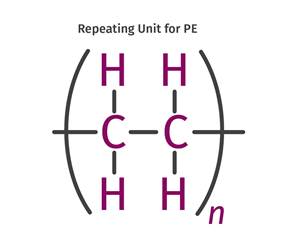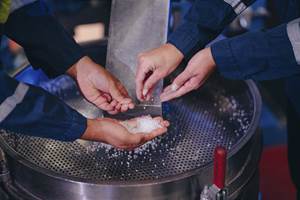Metal-Replacement PP Compounds for Sheet, Thermoforming
Resins are also said to offer options to compression and injection molding for forming form large, complex structural parts.
Two new PP compounds from SABIC — H1090 resin and STAMAX 30YH611 resin— are billed as breakthrough materials well-suited for sheet extrusion and thermoforming that are said to offer a unique alternative to traditional sheet metal forming, compression and injection molding, allowing customers to form large, complex structural parts.
These new products are 30% glass fiber-reinforced, intumescent, flame retardant materials and can be used for electric vehicle (EV) battery pack components such as top covers, enclosures and module separators. Both grades offer excellent thermal barrier properties to help delay or contain thermal runaway propagation.
Furthermore, the extrusion and thermoforming of these materials offer design, system cost, inherent thermal and electrical insulation and weight advantages vs. stamped sheet metal. Compared to injection molding of thermoplastics and compression molding for thermosets, which requires expensive tooling and equipment, extrusion and thermoforming can be more cost-effective and efficient for several cases.
SABIC’s development and validation of these new materials is made possible by BLUEHERO, an initiative that supports the automotive industry’s mission to create reliable, safe and efficient EVs, with an emphasis on helping optimize structural battery components. BLUEHERO leverages, among other things, SABIC’s knowledge of and expertise in large part molding, compression molding, thermoforming and advanced injection molding.
According to Abdullah Al-Otaibi, general manager, ETP & Market Solutions, SABIC: “By providing new alternatives to traditional materials and processes, SABIC can enable customers to design and manufacture the next generation of battery components while driving down costs and gaining a competitive advantage. Our experts have helped pioneer the successful adaptation of glass fiber-reinforced materials for the extrusion and thermoforming of large, complex, structural parts. The development and validation of these novel resins showcase SABIC’s leadership in polymer technologies for vehicle electrification.”
SABIC has validated the mechanical and fire safety performance and the manufacturability of SABIC PP compound H1090 resin and STAMAX 30YH611 resin in EV battery applications with complex geometries, both in its labs and with customers. These materials not only provide new options for the replacement of sheet metal or thermosets in final applications, they can also be used to create prototypes to determine the feasibility of investing in injection molding tools.
Combining Distinct Properties
Both short glass fiber-reinforced SABIC PP compound H1090 resin and long glass fiber-reinforced STAMAX 30YH611 resin feature a distinct combination of intumescence for fire safety and balanced stiffness and ductility. Exposing these materials to vertical and horizontal flames at 1200°C for 10 min. demonstrates excellent flame-retardant behavior. Efficient charring and intumescence keep the temperature of the reverse side of parts lower than 210°C and help prevent burn-through. Intumescence is enhanced by non-brominated/non-chlorinated FR that meets the UL94 V0 standard at 1.5 mm.
to watch a short video demonstrating a thermal runaway test with one of SABIC’s STAMAX resins.
In addition to excellent stiffness, strength and impact resistance over a wide temperature range, key properties of SABIC PP compound H1090 resin and STAMAX 30YH611 resin include dimensional stability, low coefficient of thermal expansion (CTE) and good creep resistance. As the polymer matrix for both products, PP reportedly offers good electrical insulating properties, low density, global availability and good processability.
In addition to these products, SABIC offers injection and compression moldable flame retardant long- and short-glass PP materials, which are well suited for several internal components and complete enclosures of EV battery packs.
Related Content
The Fundamentals of Polyethylene – Part 2: Density and Molecular Weight
PE properties can be adjusted either by changing the molecular weight or by altering the density. While this increases the possible combinations of properties, it also requires that the specification for the material be precise.
Read MoreDelivering Increased Benefits to Greenhouse Films
Baystar's Borstar technology is helping customers deliver better, more reliable production methods to greenhouse agriculture.
Read MorePrices of PE, PP, PS, PVC Drop
Generally, a bottoming-out appears to be the projected pricing trajectory.
Read MorePolyethylene Fundamentals – Part 4: Failed HDPE Case Study
Injection molders of small fuel tanks learned the hard way that a very small difference in density — 0.6% — could make a large difference in PE stress-crack resistance.
Read MoreRead Next
Lead the Conversation, Change the Conversation
Coverage of single-use plastics can be both misleading and demoralizing. Here are 10 tips for changing the perception of the plastics industry at your company and in your community.
Read MoreFor PLASTICS' CEO Seaholm, NPE to Shine Light on Sustainability Successes
With advocacy, communication and sustainability as three main pillars, Seaholm leads a trade association to NPE that ‘is more active today than we have ever been.’
Read More









